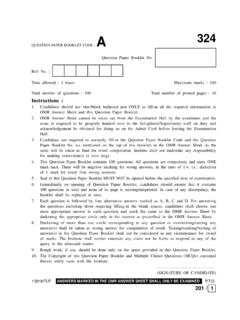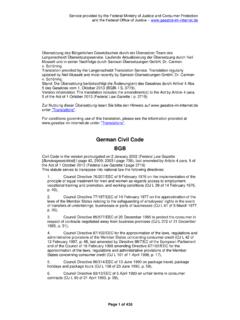Transcription of General Notes for Guidance - Box Legal
1 Solicitors' Practice Rules and Costs Information and Client Care code 1999. General Notes for Guidance An example of client care letters Format of letters It is for the solicitor to decide whether to send a client a letter or a covering letter containing important information relevant to that client together with the firm's standard terms of business. Any of these example documents could be adapted for use in another format and practitioners are encouraged to adopt their own style. However, do always have regard to the provisions of the code . Some of the individual letters may appear lengthy to clients in which case, consider sending shorter client care letters enclosing leaflets containing more General information, for example, about storage of papers and deeds/documents, or additional information, such as, an explanation of the client's rights to challenge a bill. Alternatively, it may be helpful to produce terms of business set out over the two sides of one sheet of paper only.
2 The matters covered in these documents are mainly presented in General form. Always check whether there is a need to adapt the wording in an individual case. These examples are not intended to be exhaustive. Do consider what other provisions may be appropriate for your firm. For example, if you wish to give clients an option to make payments on account by standing order and/or by credit card. Contents of letters Introduction The introductory paragraph of the letters introduces the people responsible for the client's work. It is vital to put the status of the fee earner not only to comply with the solicitors practice rule obligations, but also following Pilbrow v Pearless De Rougemont & Company (Court of Appeal, 16 March 1999) where failure to tell the client the status of the non-solicitor fee earner rendered the whole bill unenforceable. Remember the term Legal executive only applies to a fellow of the institute. Charges and Expenses 1.
3 The code Requirements Solicitors' Practice Rules and Costs Information and Client Care code 1999. The code requires solicitors to discuss with clients how any costs are to be met at the outset of, and at appropriate stages throughout the matter, and to confirm any such advice in writing as soon as possible. This is very much a matter for the practitioners in each individual case. Whilst terms of business can inform the client, matters should be discussed with them as well. Details such as whether the client's liability for costs (their own or another party's) may be covered by insurance or by an employer or trade union may be better covered in correspondence. Likewise advice on whether the likely outcome in a matter will justify the expense or risk involved including, if relevant, the risk of having to bear an opponent's cost. 2. Rule of the Civil Procedure Costs Rules In litigation matters, to ensure compliance with Rule of the Civil Procedure Costs Rules the written document providing for solicitor and client costs to be greater than those recoverable from another party must be signed by the client.
4 Failure to do so will result in costs being limited to the amount allowed from an opponent under (3) of the Solicitors Act 1974. 3. Hourly Rates In respect of hourly rates, the client should be told in advance if those rates are to be reviewed for any reason. It is generally assumed both in the letters for use in contentious and non-contentious cases that an hourly rate (whether a blended/composite rate or a rate for each type of fee earner) will be presented as a single charging rate which adequately reflects the relevant factors and the weight to be attached to them. It can often be confusing to refer to "mark-up" or "care and attention". Where the solicitor's charges are based on hourly rates, consider whether you prefer to charge routine letters sent out and consideration of letters received at six and three minutes per page or letter respectively. 4. Telephone Calls Clients frequently complain that they did not expect to have to pay for telephone calls which they make to their solicitor.
5 It may be desirable to ensure that the client understands clearly their liability for costs in this respect. 5. Money held on account While not included in the code , it is often necessary to discuss with clients the terms of investment of any money held on account. Do make clear how a deposit will be invested and what interest it will earn. A charge by a solicitor for calculating and crediting interest to a client cannot be provided for in a retainer letter or terms of business. Billing Arrangements 1. Indemnity Cover Solicitors' Practice Rules and Costs Information and Client Care code 1999. If you propose to show the cost of indemnity cover as a separate item in a bill do make it clear in the opening client care letter, terms of business or any estimate. Any wording is adequate provided it is clear. For example:- "Our basic charges for acting for you in your purchase/sale/mortgage are (however you normally charge, a fixed fee, an hourly rate, whatever).
6 In addition we are members of the Solicitors Indemnity Fund which means we are covered for claims arising out of your transaction and you are protected by comprehensive professional indemnity arrangements. We make a separate charge of X + VAT per purchase as a contribution towards the cost of that cover.". 2. Costs of a third party In non-contentious cases it may also be necessary to explain to the client any liability the client may have for the payment of the costs of a third party. 3. Disclosure of Charging Rates Solicitors doing contentious work should always bear in mind the question of the disclosure of their charging arrangements with the client to the court, including in relation to interim bills. In addition, the Lord Chancellor will be consulting shortly on a range of measures which will include: compulsory notification by solicitors to their clients of their actual charging rate;. at an early stage in all civil proceedings, solicitors will be expected to provide their clients, and the court, with an estimate of their costs to date and the full costs likely to be incurred to trial; and in addition to the above, at a later stage in civil cases, solicitors will be expected to provide an estimate of their costs to date and the full costs likely to be incurred to trial.
7 Solicitors may be expected to adhere to this final estimate or face not recovering costs incurred above it.







